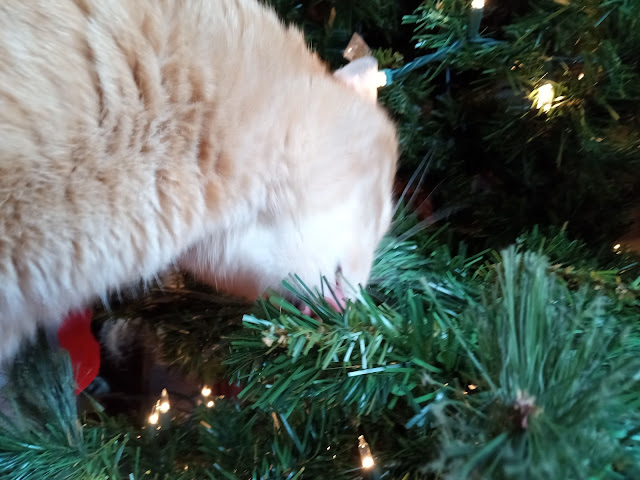The Christmas trees went up at our house on Friday. When that's going on, it's difficult to get a good photo of any of the fubabies. After all, they're all always so very excited and on the move. As for Evan, his excitement always comes in the form of, well, snacking on the Christmas trees.
We use artificial Christmas trees at our house, for a variety of reasons, some of which are probably pretty obvious. And don't worry, Evan doesn't actually eat any of the trees or their parts and pieces. He chews on them a bit, and that's it. This is how he initiates the trees every year.
Have a merry Monday, friends!
***
Flashback Doodle of the Day***
Tip of the Day
Today's Pet Diabetes Awareness Month tip is to
make sure you understand the factors that can affect blood glucose, if your furbaby has diabetes. For example, as you certainly know, food intake largely affects blood glucose levels. If your furbaby has a decreased appetite and is not eating, administering insulin can potentially lead to hypoglycemia (low blood sugar). This is because an animal gets glucose from their food. If your furbaby is not eating and is therefore not taking in food as a source of glucose, then administering insulin, which lowers blood glucose, can lead to even lower levels of glucose. So, be sure to discuss all such factors with your veterinarian, and be sure to hold off on administering insulin if your furbaby is not eating so that hypoglycemia does not result. At the same time, also be aware of other factors that could potentially affect a diabetic cat or dog's blood glucose levels, such as vomiting and diarrhea, or even dental or other issues.
Speaking of hypoglycemia, let's also mention the symptoms of and potential treatments for diabetic complications like hypoglycemia. Hypoglycemia can result in any number of symptoms, which might include increased appetite, vomiting, rapid breathing, lethargy, and difficulty walking. One quick trick to potentially help a hypoglycemic cat or dog in an emergency is to have honey, maple syrup, corn syrup, or some form of sugar syrup available. Rubbing a sugary substance such as one of these on a hypoglycemic animal's gum line or in their cheeks can help to raise their glucose to a safer level. Of course, discuss with your veterinarian any questions you have regarding hypoglycemia and reversing it. Also alert your veterinarian of any hypoglycemic events your furbaby has, so that better diabetes management can be achieved. What's more, get a hypoglycemic furbaby to the vet as soon as possible, if needed.









4 comments:
Cute shots of Evan tasting the tree. I like the drawing and your tips are great. XO
Fun times!!!
Evan, we have a video of Manny chewing on a kitchen brush that mimics what you are doing to that tree.
Must be a feline thang...
Evan, tell your mom it's called "quality control."
Post a Comment